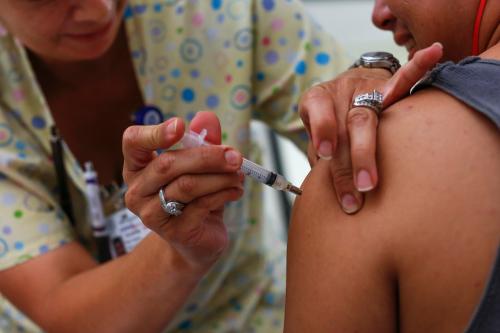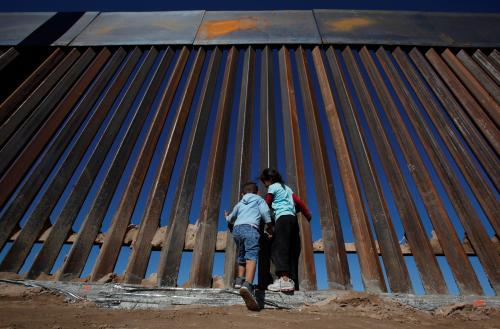On May 6th, the U.S. Immigration and Customs Enforcement agency (ICE) announced the first COVID-19 death of an immigrant detainee. Detainee deaths were bound to happen in a system that houses tens of thousands of individuals, and in which ICE has so far reported that 943 detainees have tested positive—an infection rate of 1 in 31. Additionally, 44 ICE employees at detention facilities have tested positive. The ultimate spread and lethality of COVID-19 will depend on ICE’s response to the pandemic.
In March, in response to the COVID crisis, ICE organized a working group that issued new agency-wide requirements and recommendations for detention facilities. These policies are intended to keep detainees and staff safe and healthy and ensure that when individuals are sick, they are treated and isolated from healthy individuals. The question becomes whether ICE detention facilities—with well-documented failures in meeting agency standards—will implement these new policies comprehensively and effectively. It will be critical, during the COVID-19 pandemic, for the Inspector General of the Department of Homeland Security (DHS IG) to monitor ICE’s performance.
ICE’s response to COVID-19 and potential implementation problems
The spread of COVID-19 in ICE detention facilities reflects a challenge that is happening in prison systems generally: individuals locked in close quarters are at significant risk for disease transmission. What’s more, some of the ICE facilities affected sit in or near counties that are COVID-19 hotspots. These include the Hudson County and Elizabeth facilities in New Jersey, several facilities in Louisiana, and the Stewart facility in Georgia, among others.
We have written on this blog about the risks of disease transmission not simply from detainees, but from staff who leave the facility and interact in surrounding communities and can then bring illness on their next shift. COVID-19 makes this risk even more significant as some carriers of the disease are asymptomatic.
And while waiting until March to organize the new ICE working group was troubling, its recommendations are serious and intended to create meaningful change.
Although it is controversial, some states are releasing non-violent prisoners in order to slow the spread of COVID-19 within jails and prisons. Similarly, ICE has also decided it might be wise to release some detainees and it has issued two rounds of guidance for considering the release of individuals with heightened vulnerability to COVID-19. On March 18th, all ICE field offices were ordered to review the cases of pregnant detainees as well as those over the age of 70. On April 4th, that was amended to lower the minimum age for review to 60, to include detainees who had given birth within the last two weeks, and require review of all cases in which a detainee has a chronic condition impacting their immunity. However, if the individual has been arrested for or convicted of a crime, review by higher-level officials is mandatory.
The need to release detainees is two-pronged: to get vulnerable people out of harm’s way and to prevent crowding. The April 10th requirements state that “Efforts should be made to reduce the population to approximately 75% of capacity.”[1] Requiring field offices to review at-risk detainees is a step in the right direction and is laudable; however, it is unclear whether reducing populations to 75% will still allow sufficient distancing among detainees to provide a safe environment. The agency should demonstrate that 75% is not an arbitrary number, but one that ensures health and safety.
Next, isolation for ill detainees is mandatory, and quarantine for new detainees to the facility is urged but not strictly required. Cases of suspected or confirmed COVID-19 infection must be housed separately, adhering to CDC guidelines for medical isolation “depending on the space available.” Isolated detainees may be housed together only if they all have laboratory-confirmed cases of COVID-19. “Considerable effort should be made,” under the new guidelines, to keep any new detainees in quarantine for 14 days before introducing them into the general population.
One of the key strategies for reducing the spread of COVID-19—simple hand hygiene—is also covered in the ICE requirements. Problems with sanitation and hygiene in ICE detention were well-documented in 2019. But on hand-washing, at least, the requirements are helpfully specific, stating that all facilities must: “Provide detainees and staff no-cost, unlimited access to supplies for hand cleansing, including liquid soap, running water, hand drying machines or disposable paper towels, and no-touch trash receptacles.” Hand sanitizer is to be provided “where permissible.”
Finally, ICE has changed course on its policy not to vaccinate detainees against influenza. Given the preventable deaths that have occurred in recent years due to influenza, this move is a positive one. The requirements could be stronger, however; they currently say to offer the vaccine to all detainees and staff “where possible.”
These conditional statements within ICE guidance around hand hygiene and vaccinations present serious concerns. ICE requests facilities to take specific actions “whenever possible,” or “to the extent possible” (as is the case for detainees having individual rooms). At the same time that it’s making positive policy choices, ICE is offering facilities the discretion not to meet some recommendations. This leeway is especially concerning an immigrant detention system that has a history of failing to meet even minimum requirements for detainee health and safety.
The Homeland Security Inspector General must take charge
The COVID-19 pandemic and the virus’s presence in the detention system presents a policy crisis. If those previous ICE failures continue, their effects may be magnified by the pandemic.
It will be essential to understand both in real time, and as an after-action report, ICE’s effectiveness at managing the pandemic. Throughout government, the IGs (Inspectors General) are the entities charged with conducting independent oversight, and the DHS IG would ordinarily be the agency best-positioned to monitor the situation. However, it is not at all clear that the DHS IG will be rigorous in its evaluation of ICE’s performance according to standard policies set forth by law and regulation as well as the emergency requirements and recommendations from the ICE COVID-19 working group.
One piece of evidence of a stifled DHS IG is the fact that the office has sharply decreased its oversight in the past three years. Whereas in 2016 it released 147 reports, this year so far it has released 31. In March, the Washington Post reported that not only had the Inspector General avoided making routine testimony to Congress, the office itself was sometimes deserted.
| Fiscal Year | Number of Reports* |
| 2012 | 191 |
| 2013 | 178 |
| 2014 | 155 |
| 2015 | 161 |
| 2016 | 147 |
| 2017 | 120 |
| 2018 | 89 |
| 2019 | 67 |
| 2020 | 31 |
| *Includes management reports and grant reports. | |
Worryingly, the OIG’s most recent report pertaining to immigration enforcement framed its conclusions in language that could have been lifted from the president’s own political talking points. It claims that ICE was impeded by “uncooperative jurisdictions” from preventing aliens from committing “more crimes.”
The report failed to fully articulate the reasons for non-cooperation on the part of law enforcement agencies.[2] It briefly touches on this point, stating for example “Officials of other jurisdictions cited fear of litigation for wrongful detention or erroneous detainers,” but quickly pivots to citing three cases in which an alien was released from custody and committed further crimes (p9). Anecdotal examples such as these are not the typical stock-in-trade of inspectors general, particularly not to gloss over real complexities and conflicts that exist within the realm of a given audit. ICE eagerly took up the report’s conclusions, issuing a statement echoing that local law enforcement jurisdictions prevent it from apprehending aliens who have committed crimes and allow those individuals to commit more.
In light of the threat COVID-19 presents to the population detained by ICE, it’s particularly urgent for the DHS IG to perform effective oversight of ICE on an ongoing basis. It will need to closely monitor whether ICE facilities are adhering to the new requirements for preparedness, prevention and management. And it must avoid political framings of COVID-19 that have hampered the government’s response in so many areas. The hope is that, given the grave threat that COVID-19 presents, the DHS IG can regain its footing with regard to ICE oversight and ensure that the agency’s science-based requirements are being met.
Note: A previous version of this post cited the number of ICE detention center employees with confirmed cases as 108, but that figure was for non-detention employees.
[1] The ICE website notes reductions to 70%.
[2] In the early days of the Trump administration, DHS had a short-lived, name-and-shame campaign against law enforcement agencies that declined to detain people on behalf of ICE. The Declined Detainer Reports were quickly scrapped, in part because they contained inaccuracies. Perhaps unintentionally, they provide an informative view of the case for non-cooperation. Most jurisdictions required an order from a judge in order to detain an individual and do not accept the administrative warrants provided by ICE.








Commentary
As COVID-19 spreads in ICE detention, oversight is more critical than ever
May 14, 2020